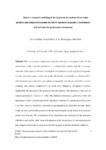Mostrar o rexistro simple do ítem
Reactive transport modelling of the long-term interactions of corrosion products and compacted bentonite in a HLW repository in granite: Uncertainties and relevance for performance assessment
| dc.contributor.author | Samper, Javier | |
| dc.contributor.author | Naves, Acacia | |
| dc.contributor.author | Montenegro, Luis | |
| dc.contributor.author | Mon, Alba | |
| dc.date.accessioned | 2024-02-05T20:17:03Z | |
| dc.date.available | 2024-02-05T20:17:03Z | |
| dc.date.issued | 2016 | |
| dc.identifier.citation | SAMPER. J., NAVES, A., MONTENEGRO L., MON, A. (2016). Reactive transport modelling of the long-term interactions of corrosion products and compacted bentonite in a HLW repository in granite: Uncertainties and relevance for performance assessment. Applied Geochemistry, 67, 42-51. https://doi.org/10.1016/j.apgeochem.2016.02.001 | es_ES |
| dc.identifier.uri | http://hdl.handle.net/2183/35423 | |
| dc.description | Versión aceptada de https://doi.org/10.1016/j.apgeochem.2016.02.001 | es_ES |
| dc.description.abstract | [Abstract:] Here we present a long-term nonisothermal reactive transport model for the interactions of the corrosion products of a carbon-steel canister and the compacted bentonite of the engineered barrier of a high-level radioactive waste repository in granite. Canister corrosion causes an increase in the pH and the concentration of dissolved Fe2+ of the bentonite porewater. Iron precipitates as magnetite and siderite and sorbs via cation exchange and surface complexation on weak sites. Magnetite precipitation reduces significantly the porosity of the bentonite near the canister. The thickness of the zone of reduced porosity is 7 cm at t = 1 Ma. This thickness increases significantly when the dependence of the corrosion rate on the chemical conditions is considered and decreases 3 cm when smectite dissolution and analcime precipitation are taken into account. Model results are not significantly sensitive to the thermal transient and the effect of temperature on the corrosion rate. The conclusions of our simulations are consistent for the most part with those reported by others for engineered barrier systems at similar chemical conditions. | es_ES |
| dc.description.sponsorship | Xunta de Galicia; 10MDS118028PR | es_ES |
| dc.description.sponsorship | Xunta de Galicia; 2012/181 | es_ES |
| dc.description.sponsorship | The research leading to this work has received funding from the PEBS Project of the European Atomic Energy Community's Seventh Framework Programme (FP7/2007–2011) under grant agreement 232598. This work was partly funded by ENRESA (Spain), the Spanish Ministry of Economy and Competitiveness (Project CGL2012-36560), FEDER funds and the Galician Regional Government (Project 10MDS118028 PR and Fund 2012/181 from “Consolidación e estruturación de unidades de investigación competitivas”, Grupos de referencia competitiva). We thank the comments, corrections and suggestions of the two anonymous reviewers which contributed to the improvement of the paper. | es_ES |
| dc.language.iso | eng | es_ES |
| dc.publisher | Elsevier | es_ES |
| dc.relation | info:eu-repo/grantAgreement/EC/FP7/232598 | es_ES |
| dc.relation | info:eu-repo/grantAgreement/MINECO/Plan Estatal de Investigación Científica y Técnica y de Innovación 2008-2011/CGL2012-36560/ES/MODELOS DE CALCULO TRANSPORTE REACTIVO EN MEDIOS POROSOS Y FRACTURADOS DE BAJA PERMEABILIDAD ESTRUCTURADOS | es_ES |
| dc.relation.uri | https://doi.org/10.1016/j.apgeochem.2016.02.001 | es_ES |
| dc.rights | Atribución-NoComercial-SinDerivadas 3.0 España | es_ES |
| dc.rights.uri | http://creativecommons.org/licenses/by-nc-nd/3.0/es/ | * |
| dc.subject | Radioactive waste | es_ES |
| dc.subject | Reactive transport | es_ES |
| dc.subject | Corrosion products | es_ES |
| dc.subject | Compacted bentonite | es_ES |
| dc.title | Reactive transport modelling of the long-term interactions of corrosion products and compacted bentonite in a HLW repository in granite: Uncertainties and relevance for performance assessment | es_ES |
| dc.type | info:eu-repo/semantics/article | es_ES |
| dc.rights.access | info:eu-repo/semantics/openAccess | es_ES |
| UDC.journalTitle | Applied Geochemistry | es_ES |
| UDC.volume | 67 | es_ES |
| UDC.startPage | 42 | es_ES |
| UDC.endPage | 51 | es_ES |
| dc.identifier.doi | 10.1016/j.apgeochem.2016.02.001 |
Ficheiros no ítem
Este ítem aparece na(s) seguinte(s) colección(s)
-
GI- AQUATERRA - Artigos [53]
-
OpenAIRE [368]






